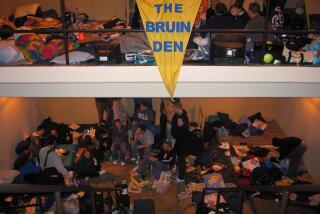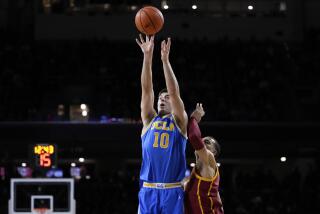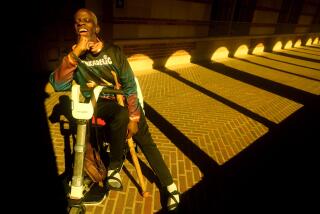The Day One Bruinâs Game Suddenly Stood Still
The worst part is in the morning, when Sean Gjos emerges from the forgiving fog of sleep and is suddenly jolted back to reality.
He remembers that his life, which had been progressing so smoothly, changed irrevocably in an instant because of a freak accident in a hockey game. He remembers he canât walk and that because he hasnât gotten a car with hand controls, heâs dependent on friends to get to doctorsâ appointments and classes at UCLAâs Anderson School, where he will receive his MBA on June 18.
Not that he can ever completely forget. But first thing every morning, he is reminded anew of the March 3 accident that crushed his 11th thoracic vertebra and damaged his spinal cord, leaving him without the use of his legs and with little feeling below his waist.
âI have to deal with reality all over again,â he said softly. âSometimes that takes a split second, sometimes that takes an hour.â
There are so many cruelties in this, so many reasons he could lament the unfairness of fate. Friends say he has maintained a remarkably positive outlook, but it isnât easy. It canât be.
Sitting in his wheelchair in the living room of his airy Santa Monica apartment--he had to leave his old place because he couldnât negotiate its multilevel layout--Gjos constantly fidgets, turning the chair this way and that, lifting the front wheels to tilt the chair at a precarious angle. When his restlessness was pointed out, he laughed.
âI never was very good at sitting,â he said. âNow Iâm sitting all the time. I always used to be moving around.â
Gjos (pronounced Joss) isnât a professional athlete. Nor was he a scholarship athlete. He paid to play club hockey for UCLA, joining an enthusiastic group of undergrads and graduate students who shell out more than $500 each for the privilege of skating at Pickwick Arena in Burbank before tiny crowds at odd hours in the middle of the week.
He didnât even play last season, his first at the Anderson School after graduating from Brown University with a degree in international relations and spending several years in investment banking. Gjos, 28, figured he was too busy with his MBA work, but love for the game he had played since his childhood on Manitoulin Island, Canada, drew him back this season.
âHe came in and fit in really great,â teammate Zachary Rynew said.
The play that changed Gjosâ life appeared innocuous, a routine hit in a game against Life College of Marietta, Ga., in the first game of the national club championship tournament at Salt Lake City. There was no sickening thud, just a collision that sent him sliding back-first into the boards.
âHe had the puck and he was passing it. It looked like he wasnât expecting to get hit,â said Rynew, a graduate student in architecture. âIt seemed pretty square and pretty clean. It didnât seem like he fell that hard. I didnât see him hit the ice. Everyone watching didnât even follow the hit because it just looked so routine.
âI was on the bench and we had been laughing, then we realized something bad had happened.â
Team captain Mike Siegel, a history major, also thought nothing of it.
âIâve seen a hit like that a thousand times,â Siegel said. âHe was off balance when he got hit, but we expected him to get up. When he didnât get up, thatâs when we got scared.â
Siegelâs mind flashed to Travis Roy, the Boston University hockey player who became a quadriplegic after being hit 11 seconds into the first shift of his college career. âThen Sean started to move his upper body, so we thought he had just gotten his wind knocked out,â Siegel said. âThen they came to take him out on a stretcher, and thatâs when the panic started.â
Gjos also sensed nothing ominous about the hit. âI remember skating into the corner after the puck with another guy,â he said. âWe were probably six feet away from the boards. We body-checked each other. It was a clean hit. He just caught me off balance. I went into the boards--I donât remember how I went into the boards. I just remember numbness swept up from my toes. I donât remember much after that.â
He was fortunate an orthopedic surgeon was in the crowd to provide rapid and appropriate treatment before an ambulance arrived. At Latter-day Saints hospital, he underwent a seven-hour operation to insert two 18-inch rods on either side of his vertebra, essentially reconstructing it and easing the pressure on his spinal cord.
âThe only âwhy me?â Iâve ever heard from Sean was right after the surgery,â teammate Ralph Vogel said. âHe said to me, âI really started to have it all. I really started to have it together.â â
After the surgery, Gjos was given less than a 5% chance of walking again. After intensive therapy three times a week and exercising with the help of his girlfriend, Roz Emmett, he believes his odds have improved. He wonât ask what they are. Heâs intent on walking again and heâs sure that day will come, in part because of recent research sparked by the accident that left actor Christopher Reeve a quadriplegic.
âIf you really want to look at it, thereâs been some amazing things in research,â said Gjos, who has some sensation in his hips and gluteal muscles but is disappointed by the weakness in his quadriceps. âItâs quite conceivable I need to wait seven years before they make advances that will fix my medical condition. If thatâs my worst case, itâs not great, but itâs not that bad. I donât want to give away seven years. In the meantime, Iâm going to keep working hard.â
Said Emmett, who develops educational software for children: âMaybe thereâs only a 3% chance, but heâs been in that 3% in so many ways throughout his life. We donât care what the doctors are saying.â
After a few days in the hospital in Salt Lake City, he was moved to UCLA Medical Center for five weeks. His parents, Rick, a retired policeman, and Gail, a nurse, were by his side. âTheyâre doing OK,â Gjos said. âItâs been difficult for my dad. Heâs always been such a strong supporter of my athletics.â
With that, his voice broke, a rare occurrence. âIt is really hard. You canât deny that,â said Emmett, whose job prevents her from spending as much time with Gjos as sheâd like. âBut with his strength of character and optimism, heâs getting through it. I try to be really positive around him. With the right resources and a lot of determination, thereâs a great chance he will have a lot of recovery.â
Vogel, a business school classmate, has been instrumental in giving Gjos logistical support and exploring ways to provide the financial support Gjos will need to continue with rehabilitation and his daily life.
According to the National Spinal Cord Injury Statistical Center, there are 183,000 to 230,000 spinal cord-injured people in the United States. Sports injuries account for 8.1% of such injuries. The average lifetime costs of medical services, equipment and living expenses for quadriplegics and paraplegics can exceed $1 million.
Gjosâ insurance covered his hospital costs, but coverage of rehabilitation sessions is limited to 50 a year, an average of one a week. âThatâs not going to get me back on my feet,â he said. âHere I was, ready to do anything I needed to do in terms of physical therapy to get back on my feet, and the insurance company is saying theyâre going to limit my access to professionals who can help. As a result, Iâve had to find other ways.â
To help him, Vogel and two classmates founded SCORE, Spinal Cord Opportunities for Rehabilitation Endowment. Established as a nonprofit organization under the auspices of the California Community Foundation, it aims to raise $500,000 to cover medical, transportation and other costs associated with spinal cord injuries. Gjos is meant to be the primary beneficiary, but Brown students and alumni, UCLA students and alumni and those who suffer spinal cord injuries while playing hockey are eligible for grants. Spinal cord injury research also may benefit. SCORE maintains a Web site with links to information on Gjos and spinal cord injury support groups (https://www.scorefund.org).
âMuch of it was done with the idea of Sean getting back up, but also to make something positive out of this unfortunate situation,â Vogel said.
Support from the school, Vogel said, has been phenomenal. An anonymous donor challenged Gjosâ class to raise $25,000 with 60% participation; more than $40,000 was raised and 60% was exceeded. Roger Enrico, of PepsiCo, promised and delivered $10,000 if participation reached 60%. The Mighty Ducks donated the proceeds from a silent auction of equipment, and several players visited Gjos in the hospital; they knew of his injury because Eric Eisner, son of Disney CEO Michael Eisner, played for UCLA.
Siegel has been selling T-shirts on campus for $15 and speaking in front of classes to tell fellow students about Gjos. Siegel hopes every little bit will help. âI think Sean will walk again,â Siegel said. âThatâs just the way he is. He has this amazing spirit.â
Said Rynew: âOut of the people on the team, heâs the only one who could handle this as well as heâs handled it.â
After he graduates, Gjos plans to dedicate three or four months to intense therapy and maximizing his recovery. He had begun hunting for a job shortly before his accident, but his chief concern now is rebuilding his life.
Hockey is still part of that life. He doesnât hate it for what it did to him. âI donât think I can blame anybody,â he said. âItâs just one of those things that happen.
âIâm pretty good about talking about this now. Part of it is I feel optimistic this isnât the end game. Part of it is I hope to make people more aware of spinal cord injuries and issues and things people in this situation have to deal with. Like everybody else, I have good days and I have bad days, but [self-pity] is not going to help me get better. There are people worse off than I am, and Iâve had a lot of support from my girlfriend and some great friends that have helped me along.â



